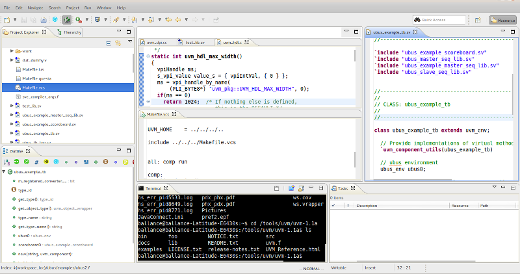DVKit: More-productive Code Development for DV Engineers
02 Jan 2018If you're a design verification (DV) engineer, how many different languages do you code in every day? If you're like me, the number is significant. On any given day, I might find myself working on SystemVerilog, PERL, shell script, Makefile, even C++. Text editors like Vim and a host of others can edit any text file, and even provide some basic syntax coloring.
How Do Integrated Development Environments Help?
Integrated Developmene Environments (IDEs) provide features far beyond those provided by simple text editors. While a text editor is typically aware of the current file being edited, an IDE is aware of the files related to the current file being edited. An IDE typically provides syntax and semantic checking for code as it is developed, which results in more accurate code creation and fewer mistakes being discovered during compilation. An IDE also provides features for navigating across the content of the code being developed -- for example, navigating to the declaration of a class from its usage. IDEs also provide on-the-fly content assist based on the declarations in the code under development -- for example, prompting the user with the methods available in a specific class.
There are a number of IDEs available, but many tend to focus on a handful of languages. Visual Studio, for example, focuses on C, C++, and C#. NetBeans focuses on Java and web languages. With the large variety of languages used for design verification, we need an IDE with support for the same large variety of languages.
Eclipse
If you're looking for a true integrated development environment (IDE) for multiple languages, the Eclipse platform is a natural choice. Originally developed by IBM as an integrated development environment for Smalltalk and Java, Eclipse has evolved into an open source platform that supports development of a dizzying array of languages -- from Java to C++ to ANTLR and beyond. As an integrated development environment, Eclipse not only provides text editing and syntax highlighting, it provides support for easily navigating code structure. For example, navigating from where a field is used to where it was declared.
DVKit
I've used Eclipse as a primary development tool for the past 12 years or so. Eclipse follows a plug-in-based architecture, and makes it easy to install new plug-ins for developing various languages. So, it's not terribly difficult to "roll your own" installation of Eclipse that contains your favorite plug-ins. About four years ago, I realized that there were two challenges with continuing to roll my own. First, it was time consuming. Remembering the web sites for all my favorite plug-ins and installing them every time a new version of Eclipse was released, on every development machine I use, was a hassle. Second, I didn't have a good way to share my favorite collection of Eclipse plug-ins with others.
So, about four years ago I created DVKit. DVKit is based on Eclipse and packages all my favorite plug-ins for developing languages such as:
- SystemVerilog
- PERL
- Python
- Shell
- C/C++
- Java
- Javascript
- Scala
- Makefile
- TCL
- XML
- YAML
DVKit is available for Linux, Windows, and Mac OS-X. On Windows, an installer is available to make it extra simple.
Over the next few blog posts, I'll introduce you to the fundamentals of developing code with DVKit and Eclipse, and some of the language-specific features provided with DVKit. In the meantime, I would encourage you to download DVKit and begin to explore how an IDE can help boost your development productivity.

